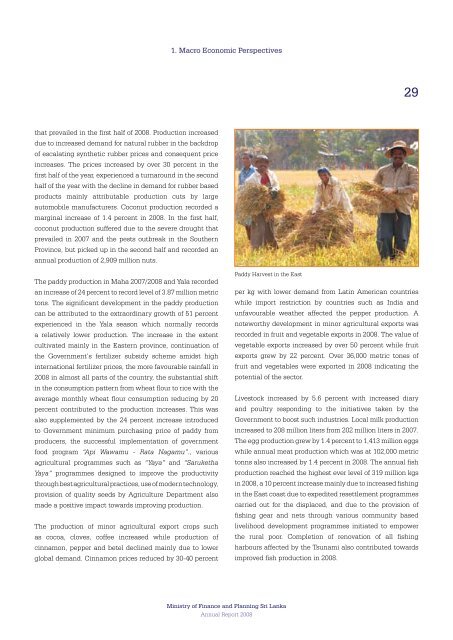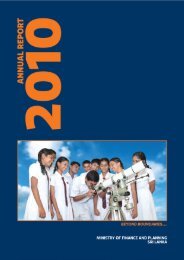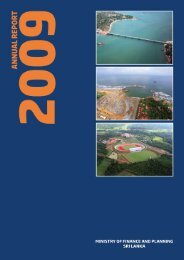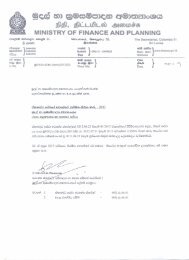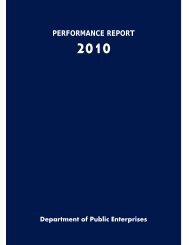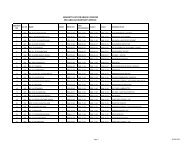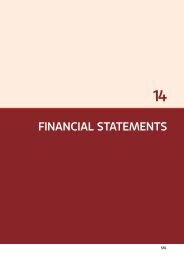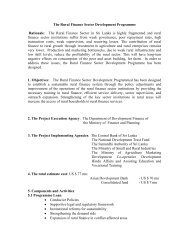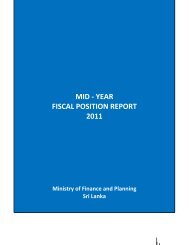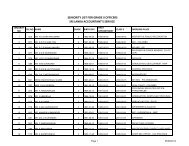Annual Report 2008 - Ministry of Finance and Planning
Annual Report 2008 - Ministry of Finance and Planning
Annual Report 2008 - Ministry of Finance and Planning
Create successful ePaper yourself
Turn your PDF publications into a flip-book with our unique Google optimized e-Paper software.
1. Macro Economic Perspectives<br />
29<br />
that prevailed in the first half <strong>of</strong> <strong>2008</strong>. Production increased<br />
due to increased dem<strong>and</strong> for natural rubber in the backdrop<br />
<strong>of</strong> escalating synthetic rubber prices <strong>and</strong> consequent price<br />
increases. The prices increased by over 30 percent in the<br />
first half <strong>of</strong> the year, experienced a turnaround in the second<br />
half <strong>of</strong> the year with the decline in dem<strong>and</strong> for rubber based<br />
products mainly attributable production cuts by large<br />
automobile manufacturers. Coconut production recorded a<br />
marginal increase <strong>of</strong> 1.4 percent in <strong>2008</strong>. In the first half,<br />
coconut production suffered due to the severe drought that<br />
prevailed in 2007 <strong>and</strong> the pests outbreak in the Southern<br />
Province, but picked up in the second half <strong>and</strong> recorded an<br />
annual production <strong>of</strong> 2,909 million nuts.<br />
The paddy production in Maha 2007/<strong>2008</strong> <strong>and</strong> Yala recorded<br />
an increase <strong>of</strong> 24 percent to record level <strong>of</strong> 3.87 million metric<br />
tons. The significant development in the paddy production<br />
can be attributed to the extraordinary growth <strong>of</strong> 51 percent<br />
experienced in the Yala season which normally records<br />
a relatively lower production. The increase in the extent<br />
cultivated mainly in the Eastern province, continuation <strong>of</strong><br />
the Government’s fertilizer subsidy scheme amidst high<br />
international fertilizer prices, the more favourable rainfall in<br />
<strong>2008</strong> in almost all parts <strong>of</strong> the country, the substantial shift<br />
in the consumption pattern from wheat flour to rice with the<br />
average monthly wheat flour consumption reducing by 20<br />
percent contributed to the production increases. This was<br />
also supplemented by the 24 percent increase introduced<br />
to Government minimum purchasing price <strong>of</strong> paddy from<br />
producers, the successful implementation <strong>of</strong> government<br />
food program “Api Wawamu - Rata Nagamu”., various<br />
agricultural programmes such as “Yaya” <strong>and</strong> “Saruketha<br />
Yaya” programmes designed to improve the productivity<br />
through best agricultural practices, use <strong>of</strong> modern technology,<br />
provision <strong>of</strong> quality seeds by Agriculture Department also<br />
made a positive impact towards improving production.<br />
The production <strong>of</strong> minor agricultural export crops such<br />
as cocoa, cloves, c<strong>of</strong>fee increased while production <strong>of</strong><br />
cinnamon, pepper <strong>and</strong> betel declined mainly due to lower<br />
global dem<strong>and</strong>. Cinnamon prices reduced by 30-40 percent<br />
Paddy Harvest in the East<br />
per kg with lower dem<strong>and</strong> from Latin American countries<br />
while import restriction by countries such as India <strong>and</strong><br />
unfavourable weather affected the pepper production. A<br />
noteworthy development in minor agricultural exports was<br />
recorded in fruit <strong>and</strong> vegetable exports in <strong>2008</strong>. The value <strong>of</strong><br />
vegetable exports increased by over 50 percent while fruit<br />
exports grew by 22 percent. Over 36,000 metric tones <strong>of</strong><br />
fruit <strong>and</strong> vegetables were exported in <strong>2008</strong> indicating the<br />
potential <strong>of</strong> the sector.<br />
Livestock increased by 5.6 percent with increased diary<br />
<strong>and</strong> poultry responding to the initiatives taken by the<br />
Government to boost such industries. Local milk production<br />
increased to 208 million liters from 202 million liters in 2007.<br />
The egg production grew by 1.4 percent to 1,413 million eggs<br />
while annual meat production which was at 102,000 metric<br />
tonns also increased by 1.4 percent in <strong>2008</strong>. The annual fish<br />
production reached the highest ever level <strong>of</strong> 319 million kgs<br />
in <strong>2008</strong>, a 10 percent increase mainly due to increased fishing<br />
in the East coast due to expedited resettlement programmes<br />
carried out for the displaced, <strong>and</strong> due to the provision <strong>of</strong><br />
fishing gear <strong>and</strong> nets through various community based<br />
livelihood development programmes initiated to empower<br />
the rural poor. Completion <strong>of</strong> renovation <strong>of</strong> all fishing<br />
harbours affected by the Tsunami also contributed towards<br />
improved fish production in <strong>2008</strong>.<br />
<strong>Ministry</strong> <strong>of</strong> <strong>Finance</strong> <strong>and</strong> <strong>Planning</strong> Sri Lanka<br />
<strong>Annual</strong> <strong>Report</strong> <strong>2008</strong>


